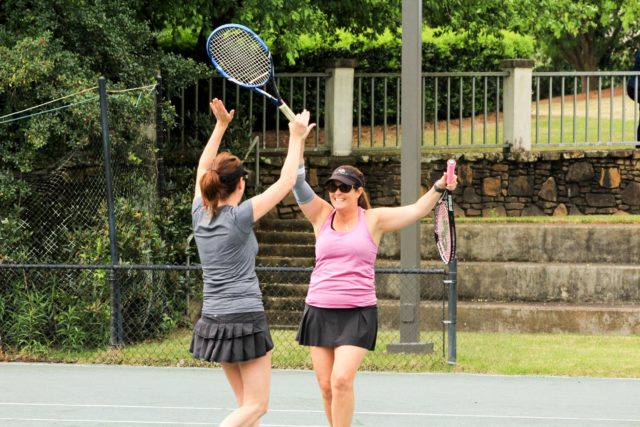By Chelsea Vea, Teaching Pro, Universal Tennis Academy-Blackburn Park
For most tennis-playing adults in Atlanta, doubles is a way of life. Unfortunately, with busy schedules and jobs, most players are not able to commit to a regular practice schedule on the court. It takes weeks or even months of repetition to learn different types of shots and to solidify technique. This creates a frustrating reality for those who compete with their ALTA or USTA teams throughout the year. People are constantly asking me what they can do to improve their game to make the biggest impact in their matches with a limited practice schedule. I believe there is one major area of improvement that most players can achieve: Learn how to communicate and move with your doubles partner. Rather than hitting a million forehands fed from a ball machine, or dragging baskets across the court to practice serves, learning to share your game plan with your partner during the point is perhaps the most effective way to work toward an elevated level of play.
Most issues teams encounter while playing doubles are not necessarily driven by bad technique but by a communication breakdown. This breakdown leads to undefended and unspoken gaps on the court. Instead, by learning how to move synchronously with a partner, doubles players can cover larger portions of the court, putting pressure on the opposing team and (hopefully) forcing them to make errors.
The primary goal for a strong doubles team should be to learn how to close off points at the net. Either through poaching or moving together to the net, the best teams are usually those who are most comfortable leaving the baseline to take advantage of offensive opportunities. When a team maintains an aggressive position at the net, their opponents are more likely to make mistakes.
Entry-level ALTA and USTA teams contain many players who feel more comfortable at the baseline because it creates more time to prepare their groundstrokes. If an opponent is willing to take advantage of this opportunity and come to the net first, they can eliminate that extra time.
Another important goal when approaching the net is to cover the largest amount of court possible, so partners should always be staggered at the net. The player positioned deeper in the court is responsible for covering the lob and setting up their partner to poach, while the player closer to the net should be more tactically aggressive, ending the point with the volley. It is vital that each partner understands their role and constantly communicates: “Yours. Mine. Back. I’ve got it!” These methods help new teams compete effectively. If a doubles team consistently communicates as they execute each point, trust will form between the players, allowing them to work together with their movements and share an understanding of the match’s strategy.
 USTA Georgia-GPTA Teaching Professional Spotlight: Chelsea Vea
USTA Georgia-GPTA Teaching Professional Spotlight: Chelsea Vea
Hometown (City/State): Peachtree City, Georgia
How did you get involved in teaching tennis? After graduating from Penn State University, I was a volunteer assistant for the Georgia State University (GSU) Women’s tennis program. While coaching their team, I was introduced to David Drew at Universal Tennis Academy and began working with him and Tim Noonan at Bitsy Grant Tennis Center. Even though I enjoyed my time with GSU, I love working with juniors and being a part of their journey to navigate their goals and path throughout their tennis careers.
Diehard fan of what sports team? Any team at Penn State
Best part of your game? Volleys
Dream doubles match would be me and… Serena Williams
When I’m not teaching tennis, I’m… traveling (pre-COVID).
My favorite tennis memory is: My entire experience playing for Penn State.
My favorite professional player is: Serena Williams
#1 reason why I enjoy teaching & coaching tennis: I love working with the kids and forming relationships with them and their families. It’s so rewarding seeing them work towards and achieve their goals.
What important tennis message do you want to promote? Keep it fun!




